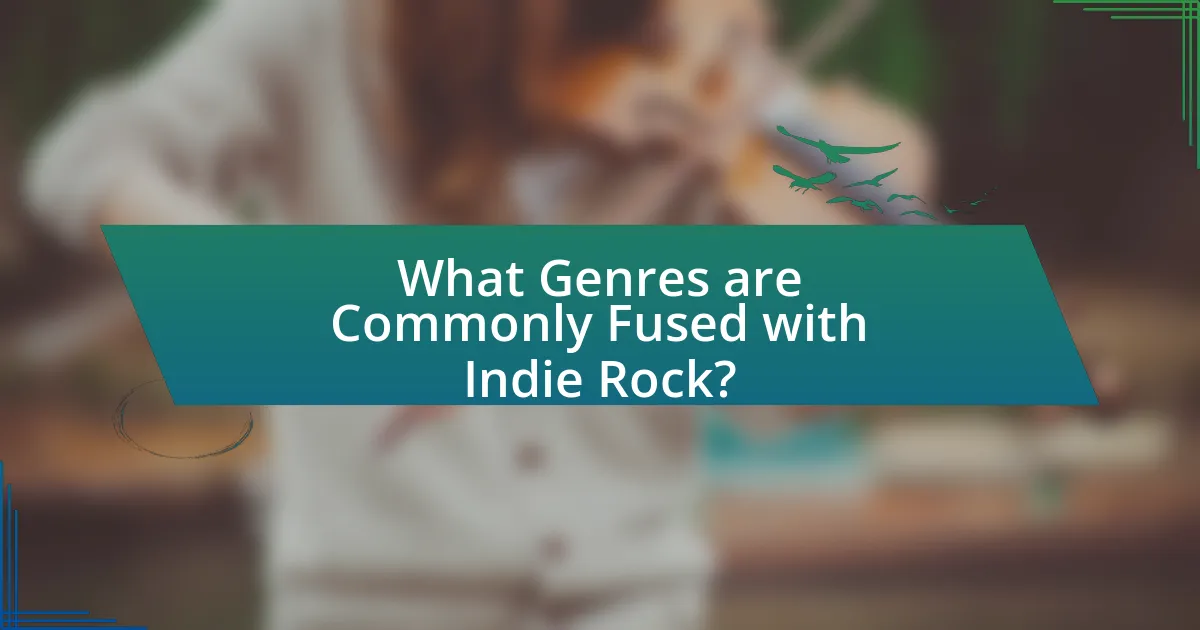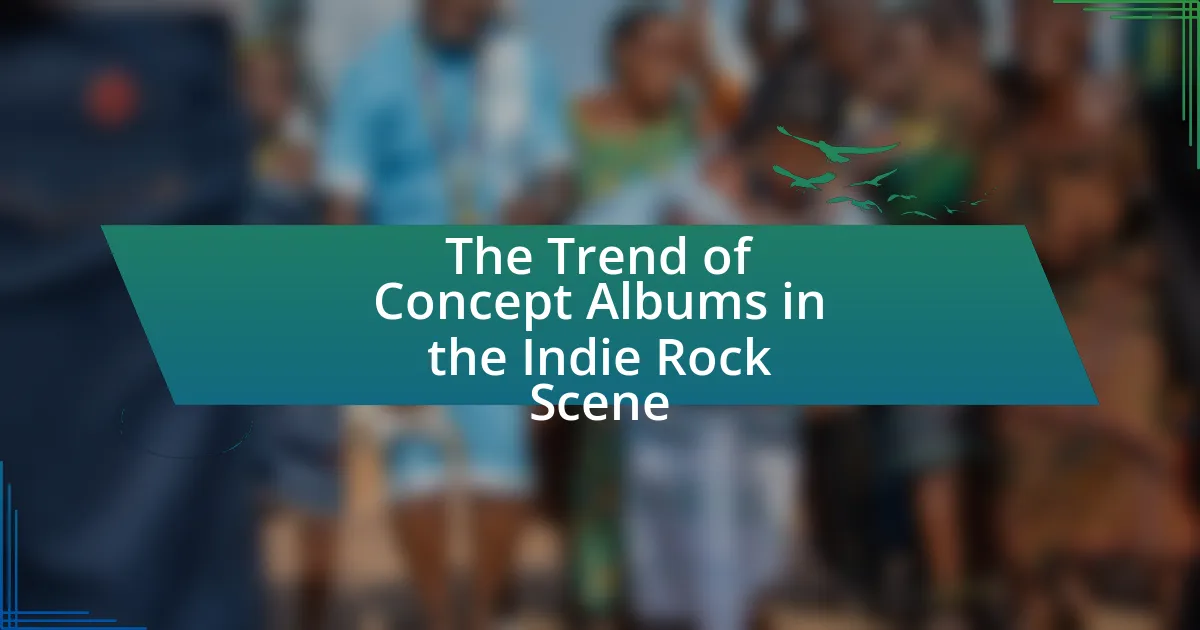The article explores the fusion of indie rock with various genres, highlighting how this blending creates innovative musical styles while maintaining the DIY ethos of indie rock. It traces the origins of this genre fusion back to the late 1980s and early 1990s, influenced by punk rock and alternative music, and discusses key artists who have successfully integrated elements from pop, electronic, folk, and hip-hop into their work. The article also examines the defining characteristics of indie rock, its differences from mainstream rock, and the significance of genre fusion in expanding creative possibilities and attracting diverse audiences. Additionally, it addresses current trends, technological influences, and strategies for artists navigating genre fusion, providing insights into the evolving landscape of contemporary music.

What is the Fusion of Indie Rock with Other Genres?
The fusion of indie rock with other genres involves the blending of indie rock’s distinct sound with elements from genres such as pop, electronic, folk, and punk. This fusion creates innovative musical styles that retain the DIY ethos of indie rock while incorporating diverse influences. For instance, bands like The xx merge indie rock with electronic music, resulting in a minimalist sound characterized by atmospheric production. Similarly, artists like Sufjan Stevens integrate folk elements into their indie rock compositions, showcasing intricate arrangements and storytelling. This genre-blending not only expands the sonic palette of indie rock but also attracts a wider audience, as evidenced by the commercial success of crossover hits that incorporate these varied influences.
How did the fusion of Indie Rock with other genres begin?
The fusion of Indie Rock with other genres began in the late 1980s and early 1990s as artists sought to break away from mainstream music conventions. This period saw bands like Sonic Youth and The Pixies incorporating elements from punk, noise rock, and alternative music, which laid the groundwork for genre blending. The rise of independent record labels and the DIY ethic encouraged experimentation, leading to collaborations with genres such as folk, electronic, and hip-hop. For instance, the 1997 album “OK Computer” by Radiohead showcased a blend of rock with electronic music, influencing many Indie Rock artists to explore diverse sounds.
What historical influences contributed to this fusion?
The historical influences that contributed to the fusion of indie rock with other genres include the punk rock movement of the 1970s, which emphasized DIY ethics and musical experimentation, and the rise of alternative rock in the 1980s and 1990s, which expanded the sonic palette of rock music. Punk rock’s rejection of mainstream norms encouraged indie artists to explore diverse sounds and styles, while alternative rock’s commercial success paved the way for genre-blending. Additionally, the emergence of electronic music in the late 20th century introduced new production techniques and sounds, further influencing indie rock’s evolution. These influences collectively shaped the genre’s willingness to incorporate elements from pop, folk, hip-hop, and electronic music, resulting in a rich tapestry of sounds within indie rock.
Which key artists played a role in this genre blending?
Key artists who played a role in blending indie rock with other genres include Sufjan Stevens, who incorporated orchestral and folk elements into his music, and Bon Iver, known for merging indie rock with electronic and folk influences. Additionally, bands like The Postal Service combined indie rock with electronic pop, while Vampire Weekend integrated Afrobeat and classical music into their sound. These artists exemplify the genre’s evolution through their innovative approaches and collaborations, demonstrating the diverse influences that shape contemporary indie rock.
What are the defining characteristics of Indie Rock?
Indie Rock is characterized by its independent production, diverse musical styles, and a focus on artistic expression over commercial success. This genre often features unconventional song structures, a DIY ethos, and a blend of influences from various genres such as punk, folk, and electronic music. Historically, the rise of Indie Rock in the 1980s and 1990s, with bands like R.E.M. and The Smiths, exemplified a departure from mainstream music, emphasizing authenticity and innovation. The genre’s defining traits include a strong lyrical focus, often introspective or socially conscious themes, and a preference for unique instrumentation and production techniques, which contribute to its distinct sound and cultural significance.
How does Indie Rock differ from mainstream rock?
Indie rock differs from mainstream rock primarily in its approach to production, distribution, and artistic freedom. Indie rock artists typically operate outside of major record labels, allowing for greater creative control and a focus on unique sound and personal expression, whereas mainstream rock often adheres to commercial trends and formulas dictated by large record companies. This distinction is evident in the diversity of sounds and themes present in indie rock, which often explores unconventional topics and experimental styles, contrasting with the more polished and commercially viable nature of mainstream rock.
What elements are commonly found in Indie Rock music?
Indie Rock music commonly features elements such as melodic guitar riffs, introspective lyrics, and a DIY (do-it-yourself) ethos. Melodic guitar riffs often serve as the backbone of the genre, creating a distinct sound that differentiates it from mainstream rock. Introspective lyrics frequently explore personal themes and emotions, contributing to the genre’s authenticity and connection with listeners. The DIY ethos emphasizes independent production and distribution, allowing artists to maintain creative control over their work. These elements collectively define the Indie Rock genre and contribute to its unique identity within the broader music landscape.
Why is genre fusion significant in the music industry?
Genre fusion is significant in the music industry because it expands creative possibilities and attracts diverse audiences. By blending elements from different genres, artists can innovate and create unique sounds that resonate with a wider range of listeners. For instance, the fusion of indie rock with electronic music has led to the emergence of subgenres like synth-pop, which gained popularity in the 2010s, exemplified by artists such as CHVRCHES and Tame Impala. This blending not only enhances artistic expression but also drives commercial success, as seen in the Billboard charts where genre-blending tracks often outperform traditional genre-specific songs.
How does genre fusion impact artist creativity?
Genre fusion enhances artist creativity by allowing musicians to blend diverse influences, resulting in innovative soundscapes and unique artistic expressions. This blending of genres encourages experimentation, as artists draw from various musical traditions, techniques, and cultural elements. For instance, the fusion of indie rock with electronic music has led to the emergence of new subgenres, such as synth-pop, which showcases how artists can redefine their sound and expand their creative boundaries. Research indicates that genre fusion can stimulate cognitive flexibility, enabling artists to think outside conventional frameworks and produce original works that resonate with broader audiences.
What are the commercial implications of genre fusion?
Genre fusion has significant commercial implications, as it allows artists to reach broader audiences and tap into multiple fan bases. By blending indie rock with genres like hip-hop, electronic, or pop, musicians can attract diverse listeners, increasing streaming numbers and sales. For instance, the collaboration between indie rock bands and mainstream pop artists has led to chart-topping hits, demonstrating the financial benefits of genre fusion. Additionally, genre fusion can enhance marketing opportunities, as brands often seek to associate with innovative sounds that resonate with varied demographics, further driving revenue streams for artists and labels.

What Genres are Commonly Fused with Indie Rock?
Indie rock is commonly fused with genres such as folk, pop, electronic, punk, and shoegaze. This fusion allows for a diverse range of sounds and styles, enhancing the indie rock genre’s appeal. For instance, the incorporation of folk elements can be seen in artists like Sufjan Stevens, while electronic influences are prominent in bands like The Postal Service. The blending of punk energy is evident in groups such as Death Cab for Cutie, and shoegaze textures can be found in the music of bands like My Morning Jacket. These genre fusions contribute to the innovative and evolving nature of indie rock.
How does Indie Rock blend with Pop music?
Indie Rock blends with Pop music through the incorporation of catchy melodies, polished production, and accessible song structures. This fusion often results in a sound that retains the artistic authenticity of Indie Rock while appealing to a broader audience typical of Pop music. For instance, artists like Tame Impala and Foster the People exemplify this blend by using synthesizers and upbeat rhythms characteristic of Pop, while maintaining the introspective lyrics and experimental sounds associated with Indie Rock. This combination has led to increased commercial success for many Indie artists, as evidenced by chart-topping hits that feature both Indie and Pop elements.
What are the notable examples of Indie Pop fusion?
Notable examples of Indie Pop fusion include the works of bands like Vampire Weekend, which blends Afrobeat influences with pop melodies, and Tame Impala, known for its incorporation of psychedelic rock elements into indie pop. Additionally, the band CHVRCHES merges synth-pop with indie sensibilities, while Florence + The Machine combines baroque pop with indie rock. These artists exemplify how Indie Pop can successfully integrate diverse musical styles, creating unique sounds that resonate with a wide audience.
How does this fusion affect the sound and style of the music?
The fusion of indie rock with other genres significantly alters the sound and style of the music by introducing diverse instrumentation, rhythms, and lyrical themes. For instance, when indie rock merges with electronic music, it often incorporates synthesizers and digital effects, resulting in a more atmospheric and layered sound. This blend can lead to innovative song structures and a departure from traditional rock formats, as seen in artists like Radiohead, who have integrated electronic elements into their work. Additionally, fusions with genres like folk or hip-hop can introduce acoustic instruments or rhythmic vocal delivery, respectively, enriching the overall texture and appeal of the music. Such cross-genre experimentation not only broadens the sonic palette but also attracts a wider audience, reflecting the evolving landscape of contemporary music.
What role does Electronic music play in Indie Rock fusion?
Electronic music plays a significant role in Indie Rock fusion by introducing innovative soundscapes and production techniques that enhance the genre’s sonic diversity. This fusion allows Indie Rock artists to experiment with electronic elements such as synthesizers, drum machines, and digital effects, creating a more textured and layered sound. For instance, bands like Radiohead and The Postal Service have successfully integrated electronic music into their work, resulting in critically acclaimed albums that push the boundaries of traditional rock. The incorporation of electronic music not only broadens the appeal of Indie Rock but also reflects the evolving landscape of contemporary music, where genre boundaries are increasingly blurred.
How have technological advancements influenced this fusion?
Technological advancements have significantly influenced the fusion of indie rock with other genres by enabling artists to access diverse sounds and production techniques. The rise of digital audio workstations (DAWs) and affordable recording equipment has democratized music production, allowing indie rock musicians to experiment with elements from genres such as electronic, hip-hop, and world music. For instance, the integration of synthesizers and sampling technology has led to innovative soundscapes that blend traditional rock instrumentation with electronic beats, as seen in the works of artists like Bon Iver and Tame Impala. Additionally, platforms like SoundCloud and Bandcamp have facilitated genre-crossing collaborations and exposure, further enriching the indie rock landscape.
What are some successful Indie Rock and Electronic collaborations?
Some successful Indie Rock and Electronic collaborations include “The Less I Know the Better” by Tame Impala featuring the electronic elements of synths and bass, which achieved critical acclaim and commercial success. Another notable collaboration is “Electric Feel” by MGMT, blending Indie Rock with electronic beats, leading to widespread popularity and recognition. Additionally, “Midnight City” by M83 showcases a fusion of dreamy Indie Rock and electronic soundscapes, becoming a defining track in both genres. These collaborations highlight the successful integration of Indie Rock and Electronic music, evidenced by chart performance and cultural impact.
How does Indie Rock interact with Folk music?
Indie Rock interacts with Folk music primarily through the blending of acoustic instrumentation and lyrical storytelling. This fusion often results in a sound that incorporates traditional folk elements, such as the use of acoustic guitars, banjos, and harmonicas, alongside the more experimental and diverse sonic textures characteristic of Indie Rock. For instance, artists like Sufjan Stevens and Fleet Foxes exemplify this interaction by merging intricate melodies and introspective lyrics typical of Folk with the innovative production techniques and stylistic diversity found in Indie Rock. This collaboration has led to a resurgence of interest in Folk music within the Indie Rock scene, as evidenced by the popularity of Folk-infused Indie albums in the 2000s and 2010s, which often charted well and received critical acclaim.
What themes are commonly explored in Indie Folk music?
Indie Folk music commonly explores themes of introspection, nature, love, and social issues. Introspection is often reflected in lyrics that delve into personal experiences and emotions, allowing listeners to connect on a deeper level. Nature is frequently depicted through imagery and storytelling, emphasizing a connection to the environment and rural life. Love, in its various forms, is a prevalent theme, capturing both the joys and complexities of relationships. Additionally, social issues such as inequality and personal struggles are addressed, providing commentary on contemporary society. These themes are supported by the genre’s acoustic instrumentation and storytelling tradition, which enhance the emotional resonance of the music.
Which artists exemplify this fusion effectively?
Artists such as Bon Iver, Tame Impala, and Vampire Weekend exemplify the fusion of indie rock with other genres effectively. Bon Iver blends indie rock with folk and electronic elements, as seen in their album “22, A Million,” which incorporates experimental sounds and auto-tuned vocals. Tame Impala merges psychedelic rock with electronic music, particularly in their album “Currents,” which features synth-heavy tracks and a modern pop sensibility. Vampire Weekend combines indie rock with Afrobeat and classical influences, evident in their album “Modern Vampires of the City,” which showcases intricate arrangements and diverse instrumentation. These artists demonstrate how indie rock can successfully integrate various musical styles, creating innovative and genre-defying sounds.

What are the Trends and Future Directions of Indie Rock Fusion?
Indie rock fusion is increasingly characterized by the blending of diverse musical styles, such as electronic, hip-hop, and world music, reflecting a trend towards genre fluidity. This evolution is driven by advancements in technology, which allow artists to experiment with sounds and collaborate across genres more easily. For instance, the rise of platforms like Bandcamp and SoundCloud has enabled indie artists to reach wider audiences and collaborate globally, leading to innovative sounds that incorporate elements from various musical traditions. Additionally, the growing popularity of festivals that celebrate genre-blending acts, such as Coachella and Lollapalooza, indicates a market demand for this fusion, suggesting that the future of indie rock will continue to embrace and expand upon these eclectic influences.
What current trends are shaping the fusion of Indie Rock?
Current trends shaping the fusion of Indie Rock include the integration of electronic elements, collaboration with hip-hop artists, and the incorporation of global music influences. The rise of electronic production techniques has led many Indie Rock bands to experiment with synths and beats, creating a sound that blends traditional rock instrumentation with modern electronic music. Collaborations with hip-hop artists have become increasingly common, as seen in projects like those of artists such as Billie Eilish and Tyler, the Creator, which merge lyrical storytelling with Indie Rock aesthetics. Additionally, the influence of global music genres, such as Afrobeat and Latin rhythms, is evident in the works of bands like Vampire Weekend, who incorporate diverse cultural sounds into their music, reflecting a broader trend of genre-blending in the contemporary music landscape.
How are social media and streaming platforms influencing these trends?
Social media and streaming platforms are significantly influencing the trends in the fusion of indie rock with other genres by providing artists with direct access to global audiences and facilitating genre-blending collaborations. These platforms enable musicians to share their work widely, allowing for the rapid dissemination of diverse sounds and styles, which encourages experimentation and innovation. For instance, Spotify’s algorithmic playlists and social media sharing features have led to increased visibility for indie rock artists who incorporate elements from pop, electronic, and hip-hop, resulting in a more eclectic music landscape. Additionally, data from the 2022 Nielsen Music report indicates that streaming services account for over 80% of music consumption, highlighting their role in shaping listener preferences and trends in genre fusion.
What emerging genres are likely to influence Indie Rock in the future?
Emerging genres likely to influence Indie Rock in the future include electronic pop, lo-fi hip-hop, and bedroom pop. Electronic pop, characterized by its use of synthesizers and digital production, has already begun to merge with Indie Rock, as seen in artists like Tame Impala and CHVRCHES. Lo-fi hip-hop, known for its relaxed beats and sampling techniques, is gaining traction among Indie Rock musicians, fostering a more laid-back sound. Bedroom pop, which emphasizes DIY production and intimate songwriting, is reshaping the Indie Rock landscape, with artists like Clairo and Rex Orange County exemplifying this trend. These genres are reshaping the sonic palette of Indie Rock, leading to innovative collaborations and new musical expressions.
How can artists successfully navigate genre fusion?
Artists can successfully navigate genre fusion by understanding the core elements of the genres they wish to blend and experimenting with their unique sound. This involves analyzing the rhythmic, melodic, and harmonic structures of both genres, allowing artists to create innovative combinations that resonate with audiences. For instance, the fusion of indie rock with electronic music has led to the emergence of sub-genres like synth-pop, where artists like CHVRCHES have effectively merged guitar-driven melodies with electronic beats, resulting in commercially successful tracks. This approach not only broadens an artist’s creative palette but also attracts diverse listener demographics, as evidenced by the growing popularity of genre-blending artists in streaming platforms, which reported a 30% increase in genre fusion playlists in recent years.
What strategies can musicians employ to blend genres effectively?
Musicians can blend genres effectively by incorporating elements from diverse musical styles while maintaining a cohesive sound. This can be achieved through techniques such as experimenting with instrumentation, utilizing varied rhythms, and integrating distinct vocal styles. For instance, the use of electronic beats in indie rock can create a fusion with electronic music, as seen in artists like M83. Additionally, collaboration with musicians from different genres can introduce new influences and ideas, enhancing the creative process. Historical examples include the blending of punk rock with reggae in the late 1970s, which led to the emergence of ska-punk, demonstrating that genre fusion can lead to innovative musical movements.
What are common pitfalls to avoid in genre fusion?
Common pitfalls to avoid in genre fusion include lack of coherence, overcomplication, and neglecting the core elements of each genre. Lack of coherence occurs when the blended genres do not complement each other, leading to a disjointed sound that confuses listeners. Overcomplication arises when artists try to incorporate too many elements from different genres, resulting in a cluttered and unfocused composition. Neglecting the core elements of each genre can dilute the authenticity of the music, making it feel inauthentic or forced. These pitfalls can hinder the effectiveness of genre fusion and alienate audiences.
What are the best practices for fans to explore Indie Rock fusion?
To explore Indie Rock fusion effectively, fans should actively seek out diverse musical influences and attend live performances. Engaging with various genres such as jazz, electronic, and folk can enhance understanding of Indie Rock’s fusion elements. Listening to curated playlists that feature Indie Rock artists collaborating with musicians from different genres provides insight into innovative sounds. Additionally, following music blogs and platforms that highlight emerging Indie Rock fusion artists can keep fans informed about new trends and releases. Research indicates that exposure to a variety of musical styles fosters a deeper appreciation and understanding of genre-blending, as seen in the works of artists like Sufjan Stevens and Bon Iver, who incorporate elements from multiple genres into their music.
How can listeners discover new Indie Rock fusions?
Listeners can discover new Indie Rock fusions by exploring curated playlists on streaming platforms like Spotify and Apple Music, which often feature emerging artists and genre-blending tracks. These platforms utilize algorithms that recommend music based on listening habits, making it easier for listeners to find Indie Rock fusions that align with their tastes. Additionally, music blogs and websites such as Pitchfork and Stereogum regularly review and highlight innovative Indie Rock artists, providing insights into new fusions. Social media platforms, particularly Instagram and TikTok, also serve as valuable resources, where artists share their work and fans promote new music, creating a community around Indie Rock fusions.
What resources are available for fans to engage with this genre fusion?
Fans can engage with the fusion of indie rock with other genres through various resources such as music streaming platforms, social media communities, and live events. Music streaming platforms like Spotify and Apple Music offer curated playlists that highlight genre-blending artists, allowing fans to discover new music that combines indie rock with elements of pop, electronic, and folk. Social media platforms, particularly Facebook and Instagram, host groups and pages dedicated to genre fusion discussions, where fans can share recommendations and connect with like-minded individuals. Additionally, live events such as music festivals often feature diverse lineups that showcase indie rock artists collaborating with musicians from other genres, providing fans with immersive experiences that celebrate this fusion.




